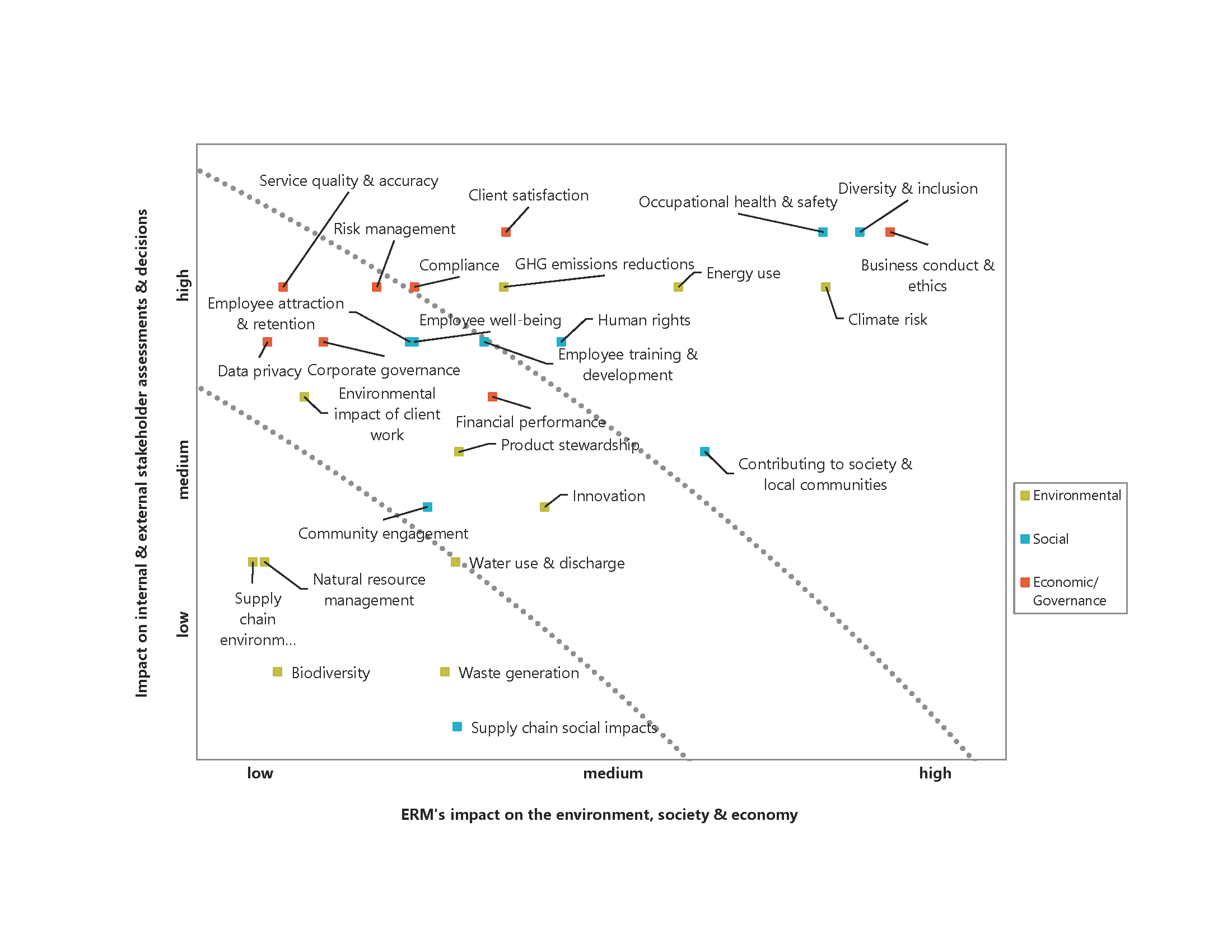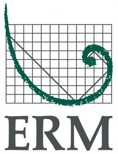Reporting approach
Our material topics

Each year, ERM conducts a formal materiality assessment in accordance with the GRI to identify and prioritize our most significant sustainability topics, set KPIs and targets for improvement, and guide the content for our Sustainability Report. Learn more about our material topics. Click on links below for more information.
We conduct annual materiality assessments as part of a three-year cycle. During year one, we undertake a comprehensive evaluation, while during years two and three, we perform a streamlined review to confirm that our material topics continue to be appropriate for our company – and make adjustments as needed.
For FY20, we returned to year one in this three- year cycle and undertook the following comprehensive approach to determine the material topics for this report:
- We convened five members of SustainAbility's (now and ERM Group company) external council to provide independent feedback on our materiality assessment process, as part of our expanded external assurance.
- We drew on a wide range of inputs to develop a view on what matters to our internal and external stakeholders, including extensive interviews, surveys and benchmarking.
- For the first time, we utilized Datamaran Materiality, an automated analysis of stakeholder views powered by artificial intelligence technology. This provided a wider perspective on environmental, social and governance issues relevant to our business.
- We expanded our understanding of ERM’s sustainability context through our involvement in various global organizations, including the World Business Council for Sustainable Development.
- We considered the implications of megatrends affecting society and our clients as well as the Sustainable Development Goals. Senior management reviewed the company’s key business issues.
- We created a matrix of key issues. Internal sustainability experts and business leaders applied the Content Principles and assessed the potential environmental, social and economic impacts – beyond the impacts on our business.

Based on this assignment, our full Executive Committee participated in a workshop to prioritize the material sustainability issues for our business going forward. Our CEO presented the results of the workshop to our Board of Directors.
- We reviewed the GRI Aspects and, where relevant, assigned indicators, which are outlined in our GRI Index.
- In order to drive performance improvement, we established key performance indicators and targets directly related to our material issues. We report on our performance against the FY21 target and long-term goals in our annual Sustainability Report.
Both internal and external factors determine what we considered to be material. These include, but are not limited to, the following:
- Reasonably estimable economic, environmental, and social impacts;
- The interests and expectations of internal stakeholders specifically invested in ERM;
- Broader economic, social, and environmental interests and topics raised by our external stakeholders;
- The main topics and future challenges for our sector, as identified by peers and competitors;
- Laws, regulations, international agreements, and voluntary agreements of strategic significance to our organization and our stakeholders;
- Key organizational values, policies, strategies, operational management systems, goals and targets;
- ERM’s core competencies and the manner in which they can contribute to sustainable development; and
- Consequences for ERM that are related to our impacts on the economy, the environment, and society. For each of the material topics, ERM defined the boundary of impact, and its relationship to the GRI Standards and ERM’s strategic business drivers (see below).
Material topic boundaries and strategic drivers
|
Material topics |
Boundary |
GRI sub-topics |
Strategic drivers |
|
Business conduct and ethics |
Internal operations and external (e.g., supply chain & clients) |
Anti-corruption, non-discrimination |
Management excellence |
|
Our people |
Internal operations and external (e.g., meeting client needs & reflecting local communities) |
Diversity and equal opportunity Training and development |
Diversity and inclusion Attracting and retaining staff Learning and development |
|
Occupational health & safety |
Internal operations and external (e.g., travel & working at client sites) |
Occupational health and safety |
Duty of care Employee well being |
|
Climate change and low carbon energy transition |
Internal operations and external (e.g., working with clients & collaborating with others) |
Emissions, Energy use |
Leadership position in the transition to low-carbon future |
|
Client satisfaction |
External (e.g., working with clients) |
Stakeholder engagement |
Responding to changing client needs |
|
Contributing to society & local communities |
Internal and external (e.g., programs & initiatives with the ERM Foundation and other organizations) |
Local communities |
Demonstrating investment in society and local communities |
These material topics are similar to the issues identified in last year’s assessment, with the following changes:
- Replaced governance with business conduct and ethics.
- Expanded climate change to explicitly include low carbon economy transition.
- Replaced innovating with clients and other leading organizations with client satisfaction.
We have developed targets specifically to address each of our material topics for FY21 targets and long-term goals.
